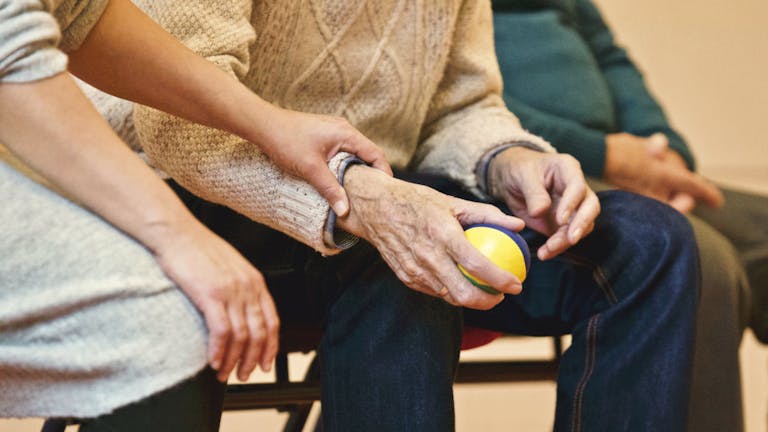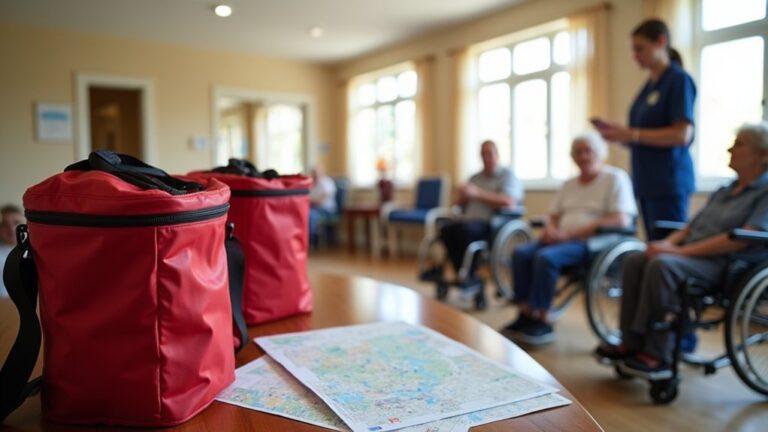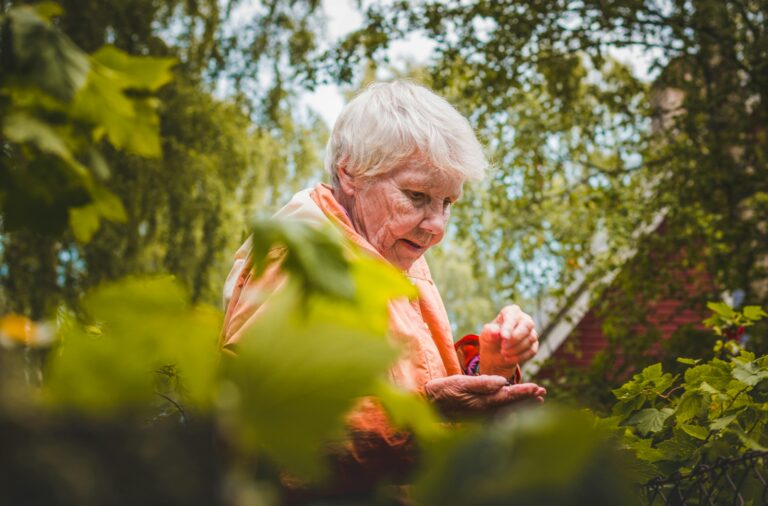Designing With Dignity: How Interior Layouts Enhance Senior Independence
When designing with dignity, you can boost your independence as a senior by focusing on interior layouts that prioritize accessibility. Opt for wider doorways to ease wheelchair access, install grab bars for safety, and use lever-style handles for simpler operation. Arrange furniture for clear pathways, and keep essentials within reach to enhance comfort. Add personal touches like family photos for emotional well-being. Stick around to uncover more ways to transform your space!
Key Takeaways
- Wide doorways and clear pathways ensure easy mobility for seniors using wheelchairs or walkers.
- Grab bars in bathrooms provide essential support, reducing fall risks and promoting confidence.
- Lever-style handles on doors and faucets simplify operation for those with limited hand strength.
- Adjustable countertops and pull-down shelves in kitchens enhance access to daily essentials.
- Bright, accessible lighting with easy switches improves visibility and safety throughout the home.
Prioritizing Accessibility in Home Design
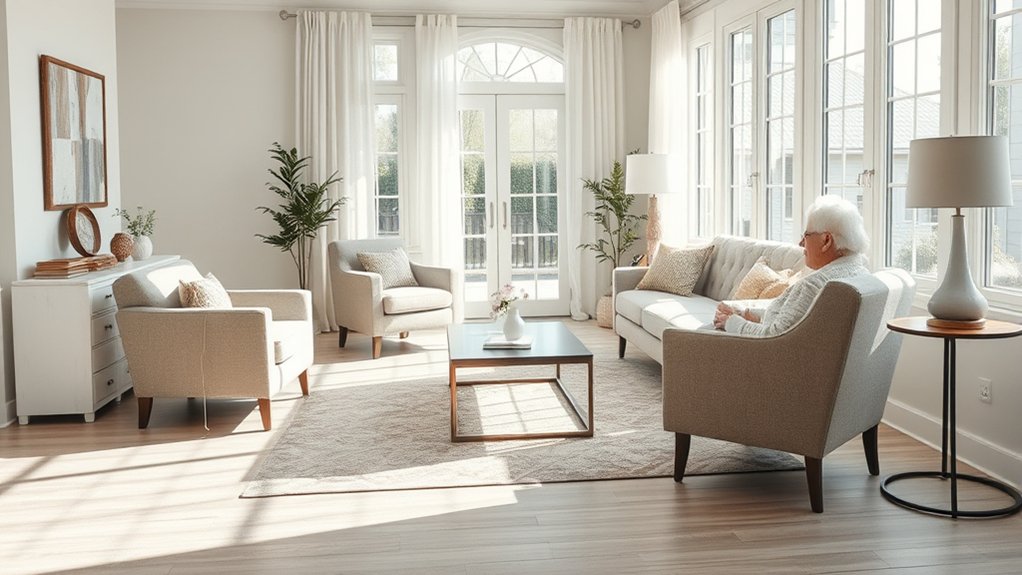
As you plan a home for senior independence, prioritizing accessibility in design becomes essential. You’re not just creating a space; you’re fostering dignity and freedom for those you care about.
Start by guaranteeing doorways are wide enough for wheelchairs, at least 32 inches, so movement feels effortless. Install grab bars in bathrooms to provide steady support, showing your thoughtfulness in every detail.
Opt for lever-style handles on doors and faucets—they’re easier to use for aging hands. Keep countertops at a comfortable height to reduce strain, and guarantee lighting is bright yet soft to aid visibility. Additionally, consider incorporating smart home features that enhance safety and convenience, ensuring peace of mind for both residents and their families.
Ensuring Safety Through Smart Layouts
While designing a home for senior independence, focus on smart layouts to guarantee safety at every turn. You can make a real difference by ensuring clear, wide pathways that prevent tripping hazards for those you care about.
Eliminate unnecessary steps or steep inclines, and install grab bars in critical areas like bathrooms to provide steady support.
Prioritize safety by removing unnecessary steps and adding grab bars in bathrooms for reliable support and peace of mind.
Think about lighting, too—place bright, accessible switches at entry points to avoid fumbling in the dark.
Keep essential items within easy reach by lowering shelves and cabinets, reducing the need to stretch or climb. Additionally, incorporating natural surroundings can enhance cognitive clarity and focus, creating a more supportive living environment.
Maximizing Comfort With Functional Spaces
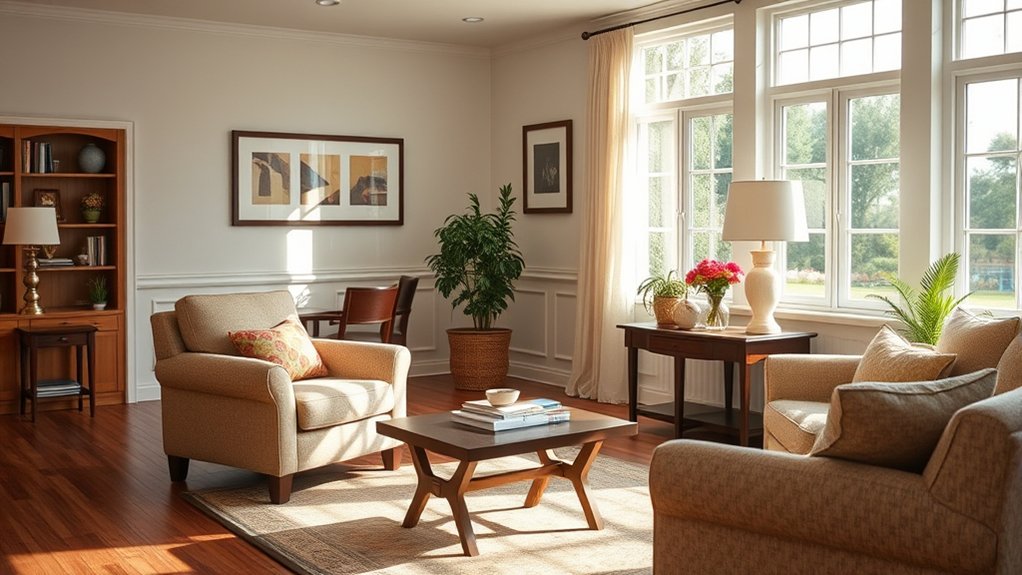
When designing for senior independence, prioritize comfort by creating functional spaces that cater to daily needs. You can transform a home into a haven by arranging furniture for easy movement and accessibility.
Place seating near windows for natural light, which boosts mood, and guarantee tables are at a comfortable height for meals or hobbies.
Consider the kitchen—position frequently used items within arm’s reach to reduce strain.
Add cozy, supportive chairs in living areas where seniors can relax or socialize.
Think about their routines and organize spaces to minimize effort, like placing storage near activity zones. Additionally, incorporating music and movement can enhance the overall atmosphere and promote emotional well-being.
Empowering Autonomy With Adaptive Features
Beyond crafting functional spaces, you can empower seniors by integrating adaptive features that support their independence.
Consider installing grab bars in bathrooms and near toilets to provide stability and prevent falls. Equip kitchens with pull-down shelves and adjustable countertops so they’re accessible for those with limited mobility. Ascertain lighting is bright yet adjustable, with easy-to-reach switches or voice-activated systems to aid visibility and safety.
You’ll also help by adding lever-style door handles and faucets, which are easier to operate for aging hands. Incorporate non-slip flooring to reduce hazards. Additionally, fostering a strong community spirit through thoughtful design can enhance socialization and engagement among residents.
Personalizing Environments for Emotional Well-Being
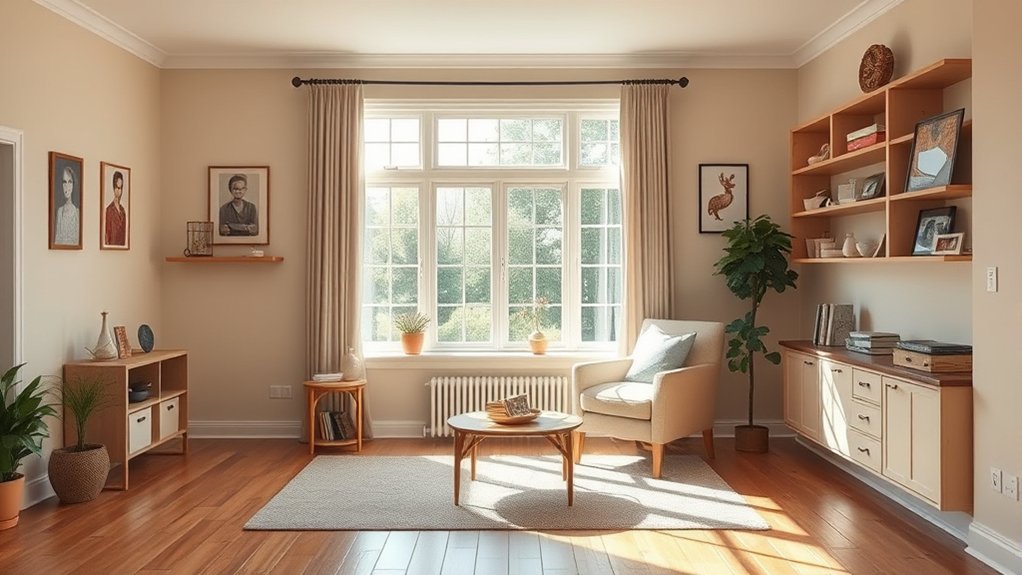
As you focus on senior independence, personalizing environments for emotional well-being becomes essential. You can transform a space into a haven by incorporating familiar items like family photos, cherished mementos, or favorite colors. These touches evoke comfort and a sense of belonging, helping seniors feel secure and valued.
You’re not just decorating; you’re crafting a space that nurtures their spirit. Consider their hobbies—set up a cozy reading nook or a small crafting corner. Involve them in decisions to honor their preferences and foster ownership.
Add soft lighting and calming textures to soothe their senses. By tailoring their surroundings, you’re showing care and respect, empowering them to thrive emotionally while maintaining dignity in their daily lives. Celebrating milestone celebrations can further enhance their emotional well-being and sense of community.
Frequently Asked Questions
How Do Cultural Preferences Influence Senior Home Designs?
Hey, have you ever thought about how cultural preferences shape senior home designs?
When you’re designing spaces for seniors, consider their heritage and traditions. Incorporate familiar elements like specific colors, furniture styles, or layouts that resonate with their background.
You’ll create a comforting environment by honoring their values. Don’t overlook small details—think about religious spaces or communal areas for family gatherings.
You’re not just building homes; you’re fostering dignity and connection.
What Funding Options Exist for Senior Home Modifications?
Hey, you’re looking to help seniors with home modifications, and funding is key!
Start by exploring government grants like those from Medicare or Medicaid if you qualify.
Don’t overlook local non-profits; they often provide financial aid or low-cost loans.
Check with the Department of Veterans Affairs if you’re a veteran.
Also, consider crowdfunding or family contributions.
You’ve got options—research and apply to make homes safer and more accessible!
How Can Technology Integrate Into Senior Living Spaces?
Hey, let’s explore how technology can integrate into senior living spaces to make life easier.
You can install smart home devices like voice-activated assistants to control lights and thermostats.
Add wearable health monitors to track essential signs and alert caregivers if needed.
Set up video doorbells for safety, so you’re always aware of visitors.
What Legal Regulations Apply to Senior Home Designs?
When considering what legal regulations apply to senior home designs, you’ve gotta immerse yourself in key laws like the Americans with Disabilities Act (ADA).
Make certain you’re meeting accessibility standards for door widths, ramp slopes, and bathroom fixtures.
Check local building codes too, as they often specify safety requirements.
How Do Community Spaces Support Senior Independence?
Hey, let’s talk about how community spaces support senior independence.
You can create environments where seniors connect, share, and thrive by designing accessible gathering spots.
Encourage social bonds with cozy seating areas and open layouts that invite interaction.
Make sure you’ve got easy navigation with clear signage and safe pathways.
When you prioritize these spaces, you’re empowering seniors to engage confidently, fostering a sense of belonging and purpose every day.



